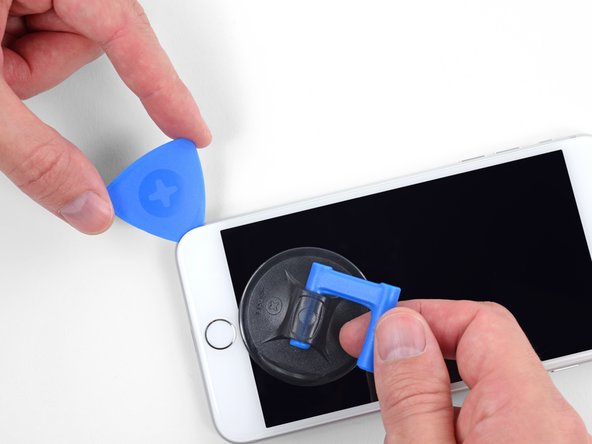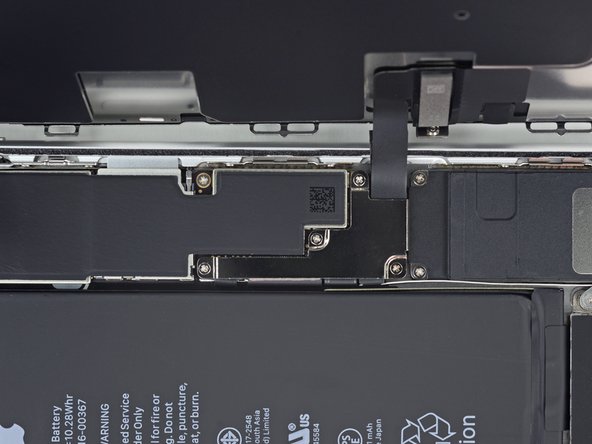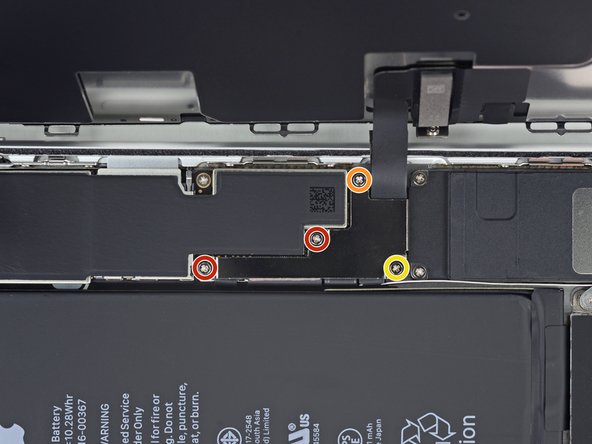iPhone 8 Plus Screen Replacement
Duration: 45 minutes
Steps: 32 Steps
Ready to give your iPhone 8 Plus a fresh face? Swapping out the screen is pretty straightforward, especially since this replacement part already has the front camera, earpiece speaker, and EMI shield installed. If your new screen is missing those bits, there’s another guide for that. The main thing you’ll need to do is move the home button from your old screen to the new one, so Touch ID keeps working. Pro tip: If auto brightness acts funky after your repair, make sure your phone’s running iOS 12. Heads up—True Tone won’t work after a screen swap, even with a genuine Apple part. If you get stuck or want a pro to handle it, you can always schedule a repair.
Step 1
Hey, before you dive in, make sure your iPhone battery is under 25%. Poking a fully charged battery can turn your repair into an accidental fireworks show—nobody wants that!
Popping open your iPhone's display will break its waterproof magic. Make sure you've got replacement seals on hand before moving forward, or be extra careful to keep your phone dry if you’re putting it back together without new seals.
- First things first, power down your iPhone. It's always a good idea to give your device a little break before diving in.
- Next, grab your trusty pentalobe screwdriver and remove the two 3.5 mm screws from the bottom edge of your iPhone. They’re easy to miss, but don’t worry, you got this!
Step 2
Pushing your opening pick in too deep can cause some unwanted damage—so let’s mark it to keep things safe and sound.
Feel free to mark the other corners of your pick with different measurements to keep your angles in check.
Another cool trick: tape a coin onto your pick about 3 mm from the tip for a handy depth guide.
- Get ready to channel your inner artist! Grab your permanent marker and measure about 3 mm from the end of the opening pick. Mark it like you mean it!
Step 3
Pop on some safety glasses—let’s keep those eyes safe just in case any bits of glass decide to make a break for it.
Got a cracked screen on your iPhone? No worries! Just throw some tape over that glass to keep it from getting worse and to keep your fingers safe while you tackle this repair.
If you're really in a pinch, a little superglue on the suction cup can help it stick to the screen like a champ.
- Cover the entire iPhone screen by layering clear packing tape strips that overlap each other.
- If the suction cup refuses to stick in the upcoming steps, grab a sturdy tape (like duct tape), fold it into a little handle, and use that to gently lift the screen instead.
Step 4
The next three steps show off the Anti-Clamp—our handy gadget for opening your device with less hassle. If you’re not using the Anti-Clamp, just skip ahead three steps for another way to get the job done.
Want the lowdown on using the Anti-Clamp? Check out our guide for the full scoop.
If your iPhone feels like a slip-n-slide and the Anti-Clamp can’t get a grip, slap on some tape to give it a little extra traction.
- Grab the blue handle and pull it back to free up the Anti-Clamp's arms.
- Slide those arms carefully over either the left or right edge of your iPhone.
- Place the suction cups near the bottom edge, just above the home button—one on the front, one on the back.
- Give the cups a gentle squeeze so they stick snugly to the area you want to work on.
Step 5
- Give that blue handle a gentle pull forward to lock those arms in place. You've got this!
- Now, let’s twist that handle clockwise a full 360 degrees, or until you see the cups starting to stretch. Keep going, you're doing great!
- Just a quick check—make sure those suction cups are still best buddies, aligned perfectly. If they start to drift apart, loosen them up a bit and line those arms back up. You're on the right track!
Step 6
Give the Anti-Clamp a gentle quarter turn, then chill for a minute before the next move. Patience pays off—let the tool do its thing!
A hair dryer, heat gun, or hot plate can help loosen things up, but watch that heat—going overboard can mess with your screen or battery.
If the Anti-Clamp isn’t giving you enough space, warm up the spot again and twist the handle another quarter turn.
- Warm up an iOpener and thread it through the arms of the Anti-Clamp.
- Fold the iOpener so it rests along the bottom edge of the iPhone.
- Give it about a minute to let the adhesive soften and an opening gap appear.
- Slide an opening pick under the screen once the Anti-Clamp has created enough space.
- Skip the next three steps.
Tools Used
Step 7
Next up, let's get that screen off with a suction cup. It's like magic, but with a little elbow grease. Give it a pull and let the suction work its charm.
A quick heat on the bottom edge of your iPhone will do wonders. The warmth helps soften the sticky stuff holding the display in place, so you can open it up without too much of a hassle.
- Grab a hairdryer or your trusty iOpener and aim it at the bottom edge of your iPhone for about 90 seconds. This will help loosen up that pesky adhesive lurking beneath!
Tools Used
Step 8
Make sure the suction cup stays clear of the home button so it can stick properly to the front glass and do its job right.
- Stick a suction cup on the lower part of the front panel, just above the home button. Let's get that panel ready for some magic!
Step 9
The waterproof adhesive holding the display down is seriously stubborn—getting that first gap open is kind of a workout. If it’s giving you attitude, hit it with more heat and gently wiggle the screen until you’ve got enough space to slide your tool in.
- Give that suction cup a steady, confident pull—just enough to crack open a tiny gap between the front and back of your device.
- Slip an opening pick or a slim pry tool into the gap, just a couple millimeters deep. No need to go spelunking—just enough to get things started.
Step 10
- Gently slide your pick around the corner and glide it up the left edge of the phone, heading towards the volume buttons and silent switch. This will loosen the adhesive holding the display in place.
- Pause once you reach the top left corner of the display.
Step 11
Heads up! There's a tiny, sensitive cable running along the right edge of your iPhone. Keep your pick away from this area to avoid any cable drama.
Step 12
Keep your pick under 3 mm deep, or those display cables might throw a tantrum.
- Pop your tool back into the lower right corner of your iPhone, and glide it smoothly around the corner and up the right edge to loosen up that sticky adhesive.
Step 13
Keep the display tilted at a maximum of 15º—going beyond that could put unnecessary stress on the ribbon cables, potentially causing them to tear. Easy does it!
- Grab the suction cup and give it a gentle pull to start lifting the bottom edge of the display—think of it as opening a stubborn jar, but with a lot less mess.
Step 14
- Grab the tiny nub on the suction cup and give it a little pull to peel it off the front panel.
Step 15
- Gently slide an opening pick under the top edge of the display to carefully loosen the last bit of adhesive holding it in place.
Step 16
- Gently nudge the display assembly downward, away from the top edge of the phone, to pop it free from the clips that are keeping it snugly attached to the rear case.
Step 17
Hold up there! Don't go trying to pull the display all the way off just yet. There are some delicate ribbon cables still keeping it connected to the iPhone's logic board, and we wouldn't want to damage those.
- Open up the iPhone by swinging the display up from the left side, just like flipping the cover of a book.
- Prop the display up against something sturdy so it stays put while you work your magic on the phone.
Step 18
- Start by unscrewing those four Phillips (JIS) screws keeping the lower display cable bracket snug on the logic board. Here are the lengths you'll need to keep track of:
- Remember, as you tackle this adventure, keep an eye on your screws! Making sure each one finds its way home during reassembly is key. A misplaced screw can lead to some serious headaches down the road.
- Two screws measuring 1.3 mm
- One screw that's 1.4 mm
- And one more, at 2.7 mm
Step 19
- Take off the lower display cable bracket with care.
Step 20
- Gently lift the battery connector from its socket using the pointy end of your spudger—like you’re popping open a tiny treasure chest.
- Tilt the connector cable up a bit so it doesn’t sneak back into its socket and accidentally power on your device while you’re working your repair magic.
Tools Used
Step 21
- Gently use the tip of a spudger or your fingernail to pop the big lower display connector straight up and out of its socket. Take it slow to keep things safe!
- When snapping connectors like this back in, press down on one side until you hear a click, then do the same on the other side. Avoid pushing in the middle to prevent bending the connector, which could cause serious damage.
Tools Used
Step 22
- Time to tackle the next cable! Unplug the second lower display cable connector, just behind the one you removed earlier. It's a simple step, but it's gotta be done!
Step 23
- Take out the two tri-point Y000 screws holding down the bracket that covers the front panel sensor assembly connector:
- One 1.0 mm screw
- One 1.2 mm screw
Step 24
- Take off the bracket that’s hiding the front panel sensor assembly connector.
Step 25
- Gently pry the front panel sensor assembly connector out of its socket using the tip of a spudger or your fingernail.
Tools Used
Step 26
- Carefully lift off the display assembly.
- If you're planning on replacing the adhesive around the edges of the display, now's the time to pause and take care of that before you continue reassembling.
Step 27
- Take out the four Y000 screws holding down the bracket over the home/Touch ID sensor:
- When putting it back together, go easy on those screws—cranking them too tight can make your home button act up.
- One screw is 1.2 mm long.
- The other three are 1.3 mm long.
Step 28
- Take off the bracket holding the home/Touch ID sensor—just a quick lift and you’re on your way!
Step 29
If the whole connector is trying to do a little flip without letting go, gently press down on the cable near the connector’s top edge with your trusty spudger. At the same time, give a little nudge to the left edge of the connector. Just a heads up, be super careful not to damage that cable or connector, or you might put the sensor out of commission for good!
- Gently slide under the left edge of the home button cable connector to carefully pop it free from its socket.
Tools Used
Step 30
Keep that display in check! It should feel just a tad warm, like a cozy hug, but not so hot that you can't touch it without jumping back.
Warming up the area around the home/Touch ID sensor is a smart move! It helps loosen the adhesive that's keeping that delicate cable nestled in place, making it way easier to lift off safely.
- Flip the display assembly over. Grab a hairdryer or get an iOpener ready, and warm up the bottom edge of the screen for about 90 seconds to loosen up that stubborn adhesive underneath.
Tools Used
Step 31
- Grab an opening pick and gently work it under the home/Touch ID sensor cable to loosen up that sticky adhesive. Take it slow and steady—no need to rush!
Step 32
- Take a moment to compare your shiny new replacement part with the original—you might need to move over a few components or peel off those pesky adhesive backings from the new one before you dive into the installation.
- To get your device back in action, simply retrace your steps from above in reverse order. Easy peasy!
- Ready to bid farewell to your e-waste? Don't forget to take it to an R2 or e-Stewards certified recycler. It's a win for you and Mother Earth!
- If things didn’t quite go as planned, don’t sweat it! Swing by our Answers community for a dose of troubleshooting advice.








































































